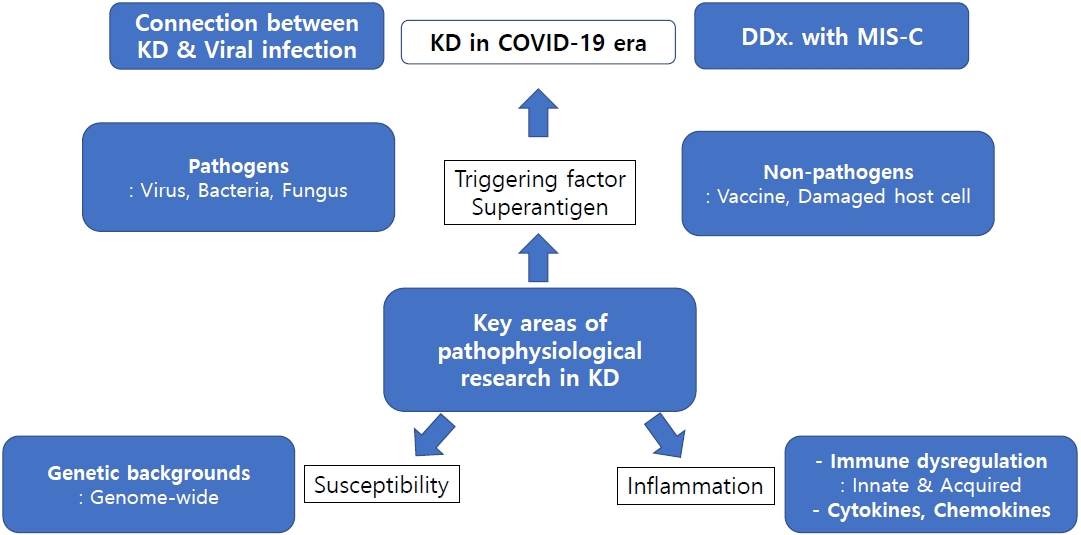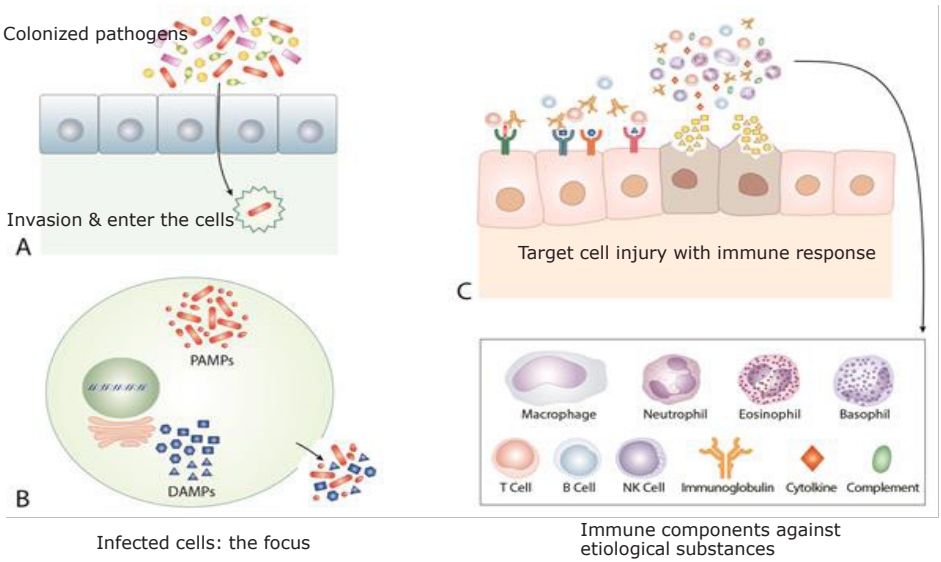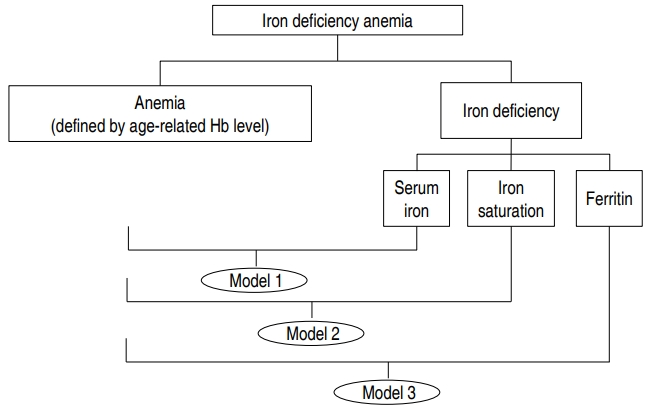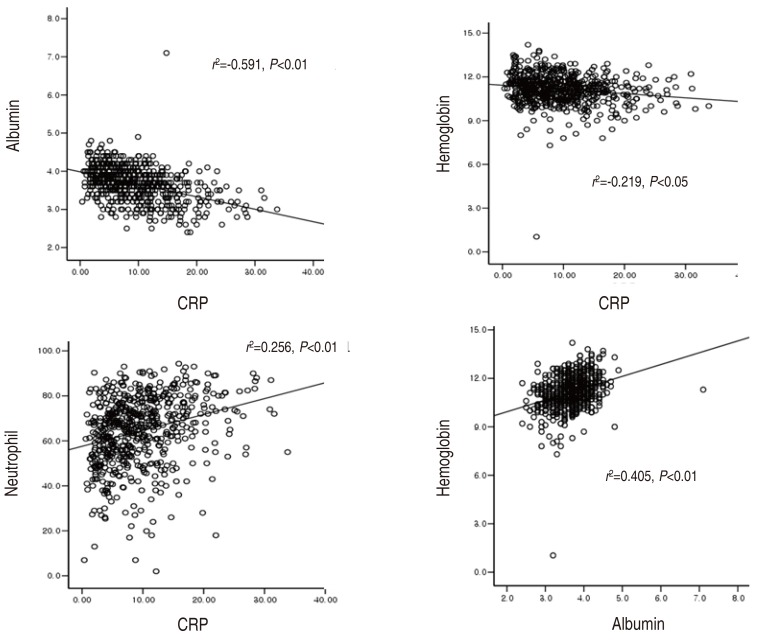Search
- Page Path
-
- HOME
- Search
- Review Article
- Cardiology
- Research trends on causes of Kawasaki disease in the COVID-19 era: focus on viral infections
- Young Hwan Lee
- Clin Exp Pediatr. 2023;66(1):1-11. Published online June 22, 2022
-

· The etiology of Kawasaki disease (KD) is unclear, but its clinical, epidemiological, and pathophysiological characteristics are strongly associated with infectious diseases.
· In the coronavirus disease 2019 pandemic era, viruses are attracting the most attention. Sudden acute respiratory syndrome coronavirus 2 infection causes various hyperinflammation in children that require differentiation from KD.
· Immune responses in patients with KD may be induced by host cell damage. To effectively prevent and treat KD, the genetic background and immune responses of KD patients and triggering pathogens require identification.
- Diagnosis of coronary artery abnormalities in Kawasaki disease: recent guidelines and z score systems
- Sung Hye Kim
- Clin Exp Pediatr. 2022;65(9):430-438. Published online December 17, 2021
-

∙ Kawasaki disease is the leading cause of acquired heart disease among children in the developed countries, and Korea has the second-highest incidence in the world.
∙ Early diagnosis and proper treatment are imperative to prevent coronary complication, and evaluation of coronary artery abnormalities is fundamental.
∙ Recent guidelines have adapted z score system for the diagnosis of coronary artery abnormalities in Kawasaki disease.
∙ Applying z score in diagnosis of coronary abnormalities has better correlation with clinical outcomes than absolute cutoff values.
∙ Calculated z scores could be different according to the z score formula, which might influence the treatment plan.
- Infection
- Etiological and pathophysiological enigmas of severe coronavirus disease 2019, multisystem inflammatory syndrome in children, and Kawasaki disease
- Jung-Woo Rhim, Jin-Han Kang, Kyung-Yil Lee
- Clin Exp Pediatr. 2022;65(4):153-166. Published online November 23, 2021
-

· Severe cases of coronavirus disease, Kawasaki disease (KD), and multisystem inflammatory syndrome in children (MIS-C) share similar findings: a protracted clinical course, multiorgan involvement, and similar activated biomarkers.
· Here we propose etiological agents in KD and MIS-C as species in the microbiota and introduce a common pathogenesis through the protein-homeostasis-system hypothesis.
· Early proper dose of corticosteroids and/or intravenous immunoglobulin may help to reduce morbidity and mortality in these diseases.
- Original Article
- Other
- Clinical spectrum and short-term outcomes of multisystem inflammatory syndrome in children in a south Indian hospital
- Muruganantham Balagurunathan, Thrilok Natarajan, Jothilakshmi Karthikeyan, Venkateshwaran Palanisamy
- Clin Exp Pediatr. 2021;64(10):531-537. Published online August 4, 2021
-

Question: What are the clinical spectrum, course, and short-term outcomes of multisystem inflammatory syndrome in children (MIS-C)?
Finding: MIS-C can have variable clinical manifestations. Fever is most common, followed by gastrointestinal and cardiovascular symptoms. Early identification and appropriate management lead to favorable outcomes.
Meaning: MIS-C can present in a myriad of ways and severities. High suspicion is necessary to ensure its early identification and appropriate management and favorable patient outcomes.
- Review Article
- General Pediatrics
- Clinical features, diagnosis, and outcomes of multisystem inflammatory syndrome in children associated with coronavirus disease 2019
- Ji Hee Kwak, Soo-Young Lee, Jong-Woon Choi; the Korean Society of Kawasaki Disease
- Clin Exp Pediatr. 2021;64(2):68-75. Published online December 30, 2020
-

Hundreds of cases of children and adolescents with hyperinflammatory responses such as Kawasaki disease have been reported amid the coronavirus disease 2019 (COVID-19) pandemic, leading to coining of the new term COVID-19–associated multisystem inflammatory syndrome in children. In this review article, we introduce the illness and describe its case definitions, epidemiology, pathogenesis, clinical features, treatments, and outcomes.
- Cardiology
- Reality of Kawasaki disease epidemiology
- Gi Beom Kim
- Clin Exp Pediatr. 2019;62(8):292-296. Published online July 9, 2019
-

Epidemiologic studies of Kawasaki disease (KD) have shown a new pattern or change of its occurrence suggestive of its pathophysiology or risk factors from the first patient with KD reported in 1961. The incidence of KD in Northeast Asian countries including Japan, South Korea, China, and Taiwan is 10–30 times higher than that in the United States and Europe. Knowing...
- Understanding the importance of cerebrovascular involvement in Kawasaki disease
- Jung Sook Yeom, Jae Young Cho, Hyang-Ok Woo
- Clin Exp Pediatr. 2019;62(9):334-339. Published online May 16, 2019
-

Kawasaki disease (KD) is a systemic vasculitis in infants and young children. However, its natural history has not been fully elucidated because the first case was reported in the late 1960s and patients who have recovered are just now entering middle age. Nevertheless, much evidence has raised concerns regarding the subclinical vascular changes that occur in post-KD patients. KD research...
- Predictors and management of intravenous immunoglobulin-resistant Kawasaki disease
- Min Seob Song
- Clin Exp Pediatr. 2019;62(4):119-123. Published online March 15, 2019
-

Kawasaki disease (KD) is a systemic vasculitis that mainly affects younger children. Intravenous immunoglobulin (IVIG) resistant cases are at increasing risk for coronary artery complications. The strategy on prediction of potential nonresponders and treatment of IVIG-resistant patients is now controversial. In this review the definition and predictors of IVIG-resistant KD and current evidence to guide management are discussed.
- Original Article
- Cardiology
- Iron deficiency anemia as a predictor of coronary artery abnormalities in Kawasaki disease
- Sohyun Kim, Lucy Youngmin Eun
- Clin Exp Pediatr. 2019;62(8):301-306. Published online February 8, 2019
-

Purpose: Coronary artery abnormalities (CAA) are the most important complications of Kawasaki disease (KD). Iron deficiency anemia (IDA) is a prevalent micronutrient deficiency and its association with KD remains unknown. We hypothesized that presence of IDA could be a predictor of CAA. Methods: This retrospective study included 173 KD patients, divided into 2 groups according to absence (group 1) and presence...
- Change of coronary artery indices according to coronary dominance pattern in early childhood
- Yoon jin Lee, Kyoung Soo Park, Hong Ryang Kil
- Clin Exp Pediatr. 2019;62(6):240-243. Published online November 22, 2018
-

Purpose: Coronary arterial lesion assessment in children can be difficult, depending on the coronary dominance pattern. Although it is easier to determine coronary dominance with echocardiography in children than in adults, it is still difficult. This study aimed to examine the coronary dominance pattern according to the objective coronary artery (CA) indices. Methods: The CA diameter, aortic valve annulus, and abdominal...
- Risk factors for the occurrence and persistence of coronary aneurysms in Kawasaki disease
- Soo-kyeong Jeon, Geena Kim, Hoon Ko, Joung-Hee Byun, Hyoung Doo Lee
- Clin Exp Pediatr. 2019;62(4):138-143. Published online November 22, 2018
-

Purpose: Prognostic factors of coronary aneurysms in Kawasaki disease have been investigated in many studies. The aim of this study was to identify risk factors associated with early and late coronary artery outcomes in treated patients with Kawasaki disease. Methods: A total of 392 patients diagnosed with Kawasaki disease from January 2012 to December 2015 in Pusan National University Children’s Hospital...
- Cardiology
- High antistreptolysin O titer is associated with coronary artery lesions in patients with Kawasaki disease
- Dong Eun Min, Do Hee Kim, Mi Young Han, Sung Ho Cha, Kyung Lim Yoon
- Clin Exp Pediatr. 2019;62(6):235-239. Published online November 7, 2018
-

Purpose: In Kawasaki disease (KD) patients, coronary artery complications, incomplete and refractory types occur more frequently in patients with streptococcal or other bacterial/viral infections. Recently, we observed a higher incidence of coronary lesions in KD patients with high anti-streptolysin O (ASO) titer. Therefore, we hypothesized that KD patients diagnosed with concurrent streptococcal infection have poor prognosis, with respect to treatment...
- Clinical implications in laboratory parameter values in acute Kawasaki disease for early diagnosis and proper treatment
- Yu-Mi Seo, Hyun-Mi Kang, Sung-Churl Lee, Jae-Won Yu, Hong-Ryang Kil, Jung-Woo Rhim, Ji-Whan Han, Kyung-Yil Lee
- Clin Exp Pediatr. 2018;61(5):160-166. Published online May 28, 2018
-

Purpose This study aimed to analyse laboratory values according to fever duration, and evaluate the relationship across these values during the acute phase of Kawasaki disease (KD) to aid in the early diagnosis for early-presenting KD and incomplete KD patients.
Methods Clinical and laboratory data of patients with KD (n=615) were evaluated according to duration of fever at presentation, and were compared between...
- Discrimination of Kawasaki disease with concomitant adenoviral detection differentiating from isolated adenoviral infection
- Jong Han Kim, Hye Ree Kang, Su Yeong Kim, Ji-Eun Ban
- Clin Exp Pediatr. 2018;61(2):43-48. Published online February 28, 2018
-
Purpose Human adenovirus infection mimics Kawasaki disease (KD) but can be detected in KD patients. The aim of this study was to determine the clinical differences between KD with adenovirus infection and only adenoviral infection and to identify biomarkers for prediction of adenovirus-positive KD from isolated adenoviral infection.
Methods A total of 147 patients with isolated adenovirus were identified by quantitative polymerase chain...
- C-reactive protein and N-terminal pro-brain natriuretic peptide discrepancy: a differentiation of adenoviral pharyngoconjunctival fever from Kawasaki disease
- Jung Eun Choi, Hee Won Kang, Young Mi Hong, Sejung Sohn
- Clin Exp Pediatr. 2018;61(1):12-16. Published online January 22, 2018
-
Purpose To differentiate adenoviral pharyngoconjunctival fever (PCF) from acute Kawasaki disease (KD) using laboratory tests before results of virus-real time polymerase chain reaction and ophthalmologic examination are obtained.
Methods Baseline patient characteristics and laboratory measurements were compared between 40 patients with adenovirus infection and 123 patients with KD.
Results The patients with adenovirus infection were generally older than those with KD (median: 3.9 years vs....
- A comparative study of established
z score models for coronary artery diameters in 181 healthy Korean children - Kyungguk Ryu, Jeong Jin Yu, Hyun Ok Jun, Eun Jung Shin, Young Hee Heo, Jae Suk Baek, Young-Hwue Kim, Jae-Kon Ko
- Clin Exp Pediatr. 2017;60(11):373-378. Published online November 27, 2017
-
Purpose The aim of this study was to investigate the statistical properties of four previously developed pediatric coronary artery
z score models in healthy Korean children.Methods The study subjects were 181 healthy Korean children, whose age ranged from 1 month to 15 years. The diameter of each coronary artery was measured using 2-dimensional echocardiography and converted to the
z score in the...
- Relationship between vitamin D levels and intravenous immunoglobulin resistance in Kawasaki disease
- Jae Sung Jun, Young Kwon Jung, Dong Won Lee
- Clin Exp Pediatr. 2017;60(7):216-220. Published online July 31, 2017
-

Purpose Vitamin D is associated with various pathological conditions such as cardiovascular diseases and cancer. We investigated the relationship between vitamin D and Kawasaki disease (KD).
Methods We performed a retrospective review of the medical records of patients with KD between February 2013 and March 2016 in Daegu Fatima Hospital. Study participants were grouped according to vitamin D serum concentration. Group 1 included...
- Association of Toll-like receptor 2-positive monocytes with coronary artery lesions and treatment nonresponse in Kawasaki disease
- Soo Jung Kang, Nam Su Kim
- Clin Exp Pediatr. 2017;60(7):208-215. Published online July 31, 2017
-
Purpose Activation of Toll-like receptor 2 (TLR2) present on circulating monocytes in patients with Kawasaki disease (KD) can lead to the production of proinflammatory cytokines and interleukin-10 (IL-10). We aimed to determine the association of the frequency of circulating TLR2+/CD14+ monocytes (FTLR2%) with the outcomes of KD, as well as to compare FTLR2% to the usefulness of sIL-10.
Methods The FTLR2% in patients...
- The outcome of short-term low-dose aspirin treatment in Kawasaki disease based on inflammatory markers
- Jae Won Yoo, Ji Mok Kim, Hong Ryang Kil
- Clin Exp Pediatr. 2017;60(1):24-29. Published online January 24, 2017
-
Purpose Previously, Kawasaki disease (KD) treatment with low-dose aspirin was administered for 6–8 weeks after the acute phase. However, inflammatory marker levels normalize before 6–8 weeks. In this study, we aimed to investigate the clinical outcome of short-term low-dose aspirin treatment based on inflammatory and thrombotic marker levels.
Methods We performed a retrospective review of the medical records of patients with KD who...
- Predictive factors of resistance to intravenous immunoglobulin and coronary artery lesions in Kawasaki disease
- Hye Young Lee, Min Seob Song
- Clin Exp Pediatr. 2016;59(12):477-482. Published online December 31, 2016
-
Purpose We conducted a study to determine which factors may be useful as predictive markers in identifying Kawasaki disease (KD) patients with a high risk of resistance to intravenous immunoglobulin (IVIG) and developing coronary artery lesions (CAL).
Methods We enrolled 287 patients in acute phase of KD at a single center. The demographic, clinical and laboratory data were collected retrospectively.
Results There were 34 patients...
- Case Report
- Cardiology
- A 2-month-old boy with hemolytic anemia and reticulocytopenia following intravenous immunoglobulin therapy for Kawasaki disease: a case report and literature review
- Na Yeon Kim, Joon Hwan Kim, Jin Suk Park, Soo Hyun Kim, Yeon Kyung Cho, Dong Hyun Cha, Ki Eun Kim, Myung Suh Kang, Kyung Ah Lim, Youn Ho Sheen
- Clin Exp Pediatr. 2016;59(Suppl 1):S60-S63. Published online November 30, 2016
-
Herein, we report a rare case of hemolytic anemia with reticulocytopenia following intravenous immunoglobulin therapy in a young infant treated for Kawasaki disease. A 2-month-old boy presented with fever lasting 3 days, conjunctival injection, strawberry tongue, erythematous edema of the hands, and macular rash, symptoms and signs suggestive of incomplete Kawasaki disease. His fever resolved 8 days after treatment with...
- Original Article
- Cardiology
- Prediction of unresponsiveness to second intravenous immunoglobulin treatment in patients with Kawasaki disease refractory to initial treatment
- Euri Seo, Jeong Jin Yu, Hyun Ok Jun, Eun Jung Shin, Jae Suk Baek, Young-Hwue Kim, Jae-Kon Ko
- Clin Exp Pediatr. 2016;59(10):408-413. Published online October 17, 2016
-
Purpose This study investigated predictors of unresponsiveness to second-line intravenous immunoglobulin (IVIG) treatment for Kawasaki disease (KD).
Methods This was a single-center analysis of the medical records of 588 patients with KD who had been admitted to Asan Medical Center between 2006 and 2014. Related clinical and laboratory data were analyzed by univariate and multivariate logistic regression analyses.
Results Eighty (13.6%) of the 588 patients...
- Prediction of nonresponsiveness to medium-dose intravenous immunoglobulin (1 g/kg) treatment: an effective and safe schedule of acute treatment for Kawasaki disease
- Kyung Pil Moon, Beom Joon Kim, Kyu Jin Lee, Jin Hee Oh, Ji Whan Han, Kyung Yil Lee, Soon Ju Lee
- Clin Exp Pediatr. 2016;59(4):178-182. Published online April 30, 2016
-
Purpose Medium-dose (1 g/kg) intravenous immunoglobulin (IVIG) is effective in the majority of patients with Kawasaki disease (KD) but some patients who do not respond to medium-dose IVIG are at high risk for the development of coronary artery lesions (CALs). The purpose of this study was to identify the clinical predictors associated with unresponsiveness to medium-dose IVIG and the development of...
- Usefulness of anterior uveitis as an additional tool for diagnosing incomplete Kawasaki disease
- Kyu Jin Lee, Hyo Jin Kim, Min Jae Kim, Ji Hong Yoon, Eun Jung Lee, Jae Young Lee, Jin Hee Oh, Soon Ju Lee, Kyung Yil Lee, Ji Whan Han
- Clin Exp Pediatr. 2016;59(4):174-177. Published online April 30, 2016
-
Purpose There are no specific tests for diagnosing Kawasaki disease (KD). Additional diagnostic criteria are needed to prevent the delayed diagnosis of incomplete Kawasaki disease (IKD). This study compared the frequency of coronary artery lesions (CALs) in IKD patients with and without anterior uveitis (AU) and elucidated whether the finding of AU supported the diagnosis of IKD.
Methods This study enrolled patients diagnosed...
- Comparison between Kawasaki disease with lymph-node-first presentation and Kawasaki disease without cervical lymphadenopathy
- Jung Ok Kim, Yeo Hyang Kim, Myung Chul Hyun
- Clin Exp Pediatr. 2016;59(2):54-58. Published online February 29, 2016
-
Purpose We evaluated the characteristics of patients with Kawasaki disease (KD) who presented with only fever and cervical lymphadenopathy on admission, and compared them with the characteristics of those who presented with typical features but no cervical lymphadenopathy.
Methods We enrolled 98 patients diagnosed with KD. Thirteen patients had only fever and cervical lymphadenopathy on the day of admission (group 1), 31 had...
- Sensorineural hearing loss in patients with Kawasaki disease
- Sun Young Park, Young Hyun Kim, Yeo Hyang Kim, Myung Chul Hyun, Young Hwan Lee
- Clin Exp Pediatr. 2015;58(11):434-439. Published online November 22, 2015
-
Purpose Kawasaki disease involves acute febrile systemic vasculitis that can cause a variety of symptoms by affecting various organs. Here, we aimed to evaluate the prevalence, causes, and prognosis of sensorineural hearing loss (SNHL) occurring in children with Kawasaki disease.
Methods Patients who were diagnosed with Kawasaki disease and received inpatient treatment in the Pediatrics Department at one of three university hospitals in...
- Uveitis as an important ocular sign to help early diagnosis in Kawasaki disease
- Han Seul Choi, Seul Bee Lee, Jung Hyun Kwon, Hae Soon Kim, Sejung Sohn, Young Mi Hong
- Clin Exp Pediatr. 2015;58(10):374-379. Published online October 21, 2015
-
Purpose Incomplete Kawasaki disease (KD) is frequently associated with delayed diagnosis and treatment. Delayed diagnosis leads to increasing risk of coronary artery aneurysm. Anterior uveitis is an important ocular sign of KD. The purpose of this study was to assess differences in laboratory findings, including echocardiographic measurements, clinical characteristics such as fever duration and treatment responses between KD patients with and...
- Diagnostic characteristics of supplemental laboratory criteria for incomplete Kawasaki disease in children with complete Kawasaki disease
- Hyun Ok Jun, Jeong Jin Yu, So Yeon Kang, Chang Deok Seo, Jae Suk Baek, Young-Hwue Kim, Jae-Kon Ko
- Clin Exp Pediatr. 2015;58(10):369-373. Published online October 21, 2015
-
Purpose In 2004, the American Heart Association (AHA) had published an algorithm for the diagnosis of incomplete Kawasaki disease (KD). The aim of the present study was to investigate characteristics of supplemental laboratory criteria in this algorithm.
Methods We retrospectively examined the medical records of 355 patients with KD who were treated with intravenous immunoglobulin (IVIG) during the acute phase of the disease....
- Review Article
- Update of genetic susceptibility in patients with Kawasaki disease
- Kyung Lim Yoon
- Clin Exp Pediatr. 2015;58(3):84-88. Published online March 20, 2015
-
Kawasaki disease (KD) is an acute systemic vasculitis that predominantly affects children, and can result in coronary artery lesions (CAL). A patient with KD who is resistant to treatment with intravenous immunoglobulin (IVIG) has a higher risk of developing CAL. Incomplete KD has increased in prevalence in recent years, and is another risk factor for the development of CAL. Although...
- Vascular health late after Kawasaki disease: implications for accelerated atherosclerosis
- Yiu-Fai Cheung
- Clin Exp Pediatr. 2014;57(11):472-478. Published online November 30, 2014
-
Kawasaki disease (KD), an acute vasculitis that primarily affects young children, is the most common acquired paediatric cardiovascular disease in developed countries. While sequelae of arterial inflammation in the acute phase of KD are well documented, its late effects on vascular health are increasingly unveiled. Late vascular dysfunction is characterized by structural alterations and functional impairment in term of arterial...
-

-
-

-

-
Impact Factor4.2
-
6.52022CiteScore92nd percentilePowered by







